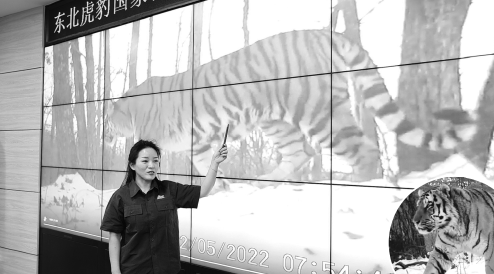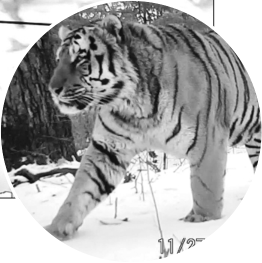Processing patterns
A staff member at a national park is helping to tag Siberian tigers in China, report Liu Mingtai and Zhou Huiying in Changchun.

Duan Lianru spends several hours sitting in her office in Hunchun, Jilin province, daily, seeing hundreds of photos of the Siberian tiger on her computer.
"It seems a little boring, but I really enjoy the work, which makes an intangible connection between me and the big cat," says the 36-year-old monitor from the research monitoring center of Hunchun bureau of the Northeast China Tiger and Leopard National Park.
The park stretches across the provinces of Jilin and Heilongjiang.
Duan is responsible for identifying the tigers according to the patterns on their fur and giving them exclusive serial numbers — something like an identity card.
"The pattern on each Siberian tiger is as unique as a human fingerprint," she says. "My work is distinguishing different individuals according to the position, length, width, color and shape of the patterns."
However, 10 years ago, Duan couldn't have imagined that there would be any connection with the big cat in her life. Born in Jiamusi, Heilongjiang province, Duan chose computer science as her major at Northeast Petroleum University in the province's Daqing city.
After graduation in 2008, she found a job as an office clerk at a private company in Shenzhen, Guangdong province. To live with her husband after their marriage in 2013, Duan quit her job in Shenzhen and moved to Hunchun. She became a guide and interpreter at an ecological experience museum of the Hunchun forestry bureau.
"The museum displays knowledge on dozens of wild animals living in the region, including tigers, Amur leopards and some other endangered species," she says. "Growing up in an urban area, I seldom had the chance to get much information about wildlife."
To make her interpretation more professional and vivid, Duan has spent much of her spare time learning about wildlife.
"That was when I got interested in big cats. The study has high scientific research value," she says. "Every year, the bureau holds training courses for us, and we learn a lot from forestry experts."
With the rich experience she has accumulated over the years, she was selected to the position in 2020.
In the same year, a high-tech surveillance system was put into operation in the Northeast China Tiger and Leopard National Park, providing real-time protection of fauna and flora. The system integrates modern communication, artificial intelligence and cloud computing, helping capture images of Siberian tigers and Amur leopards, according to the park.
The park, which covers more than 1.4 million hectares, is the most important habitat and breeding area for wild Siberian tigers and Amur leopards in China.
Data from the park shows that there are more than 50 Siberian tigers and over 60 Amur leopards in the area, and the survival rate of Siberian tiger cubs has increased from 33 percent before the establishment of the park in 2016 to 50 percent this year. Over 5,000 infrared cameras have been set up to record the living conditions of wild tigers and leopards in the Hunchun administrative region, which has an area of 275,968 hectares.
"We need to get photos of a tiger's left and right sides to make sure that it is the same one," she says. "Sometimes, I can identify a tiger within one day, but sometimes it takes over half a year."
The Siberian tigers' "ID cards "come with a lot of information, including the animals' activity areas, food chain and mating conditions — important basic data that aids scientific conservation.
Based on such information, Duan draws the family trees of the tigers.
"In recent years, we have seen a remarkable increase in the variety and number of wild animals, thanks to improved conservation efforts," she says. "I can find more tiger families, including some back two or three generations.
"I feel quite honored to be involved in wildlife conservation," she says. "I hope humans and wild animals can live in harmony to create a more beautiful world."

































